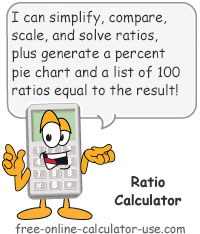IMPORTANT: Numeric entry fields must not contain dollar signs, percent signs, commas, spaces, etc. (only digits 0-9 and decimal points are allowed).
Click the Terms tab above for a more detailed description of each entry.
Step #1:
If you want to simplify a ratio, enter values for A and B.
If you want to solve for a missing value, enter any 3 of the 4 terms.
If you want to compare two ratios, enter values for A, B, C, and D.
Step #2:
Click the calculate button ("Simplify Ratio," "Solve Ratio," or "Check Equality"), which will perform the desired calculation and generate a step-by-step explanation showing how the calculator arrived at the result.



Follow me on any of the social media sites below and be among the first to get a sneak peek at the newest and coolest calculators that are being added or updated each month.